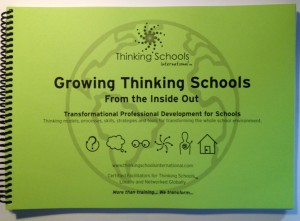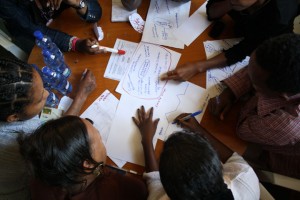


Using Rubrics as Guides for Determining Accreditation Status
The 5 Key Areas for Reflection and the 15 Criteria associated with them help focus a school’s attention on the indicators for determining where they are in the journey of developing as a thinking school. The use of the rubrics below—the Comprehensive Rubric and the Summary Rubric, provides an opportunity for the school and the accrediting partner to organize the information in the portfolio and make a clear determination of progress. With the clarity gained from this process, schools are able to make informed decisions about the future direction of their journey, the priorities they need to set, and the actions they need to undertake.
Download the Thinking Schools Rubric as a PDF file
Guiding Criteria:
1. Student Centered Learning
Students’ development as thoughtful, caring, responsible learners is reflected in learning outcomes, attitudes, behavior of pupils, across diverse populations.
2. Student Fluency
A high percentage of students are fluent with skills, tools, and models and use them in an integrated manner.
3. Communicating Learning
Media/technologies are used by students with thinking models to access, process, and communicate ideas.
• Reflective Questions:
"In what ways do our students demonstrate the impact that the thinking models have had on their development as learners?"
"To what degree are our students able to use the skills, tools, and models fluently and in an integrated manner?"
"How have our students been able to incorporate the thinking models with their use of technology and media?"
Guiding Criteria:
4. School Leadership Team
A vibrant and highly effective "Drive Team" reflecting support and involvement from key stakeholders in the school community has been developed and is actively engaged.
5. Implementation Plan
A clearly articulated long-term plan for the introduction of the thinking models and for their growth beyond the accreditation process has been designed and is being actively followed.
6. Learning Centered Leadership
The leader incorporates the thinking models in coaching and guiding reflective practice, supporting active, purposeful engagement and collaboration, and for promoting thought-filled decision-making.
• Reflective Questions:
"What role has the Drive Team played in leading the school through the Thinking Schools process and how have they been able to engage the entire school community?"
"How does the plan for developing our school as a thinking school reflect a commitment to this process over time and to what degree is it being effectively used to guide decision-making as we move forward?"
"in what ways do the practices of the school leader(s) support and promote reflection, purposeful interactions and thought-filled decision-making for both individuals and groups within the school community?"
Guiding Criteria
7. Professional Development
Ongoing, systematic professional learning opportunities are provided to develop and support expertise of the thinking models and to sustain their integrated use over time.
8. Differentiation for Educators
Teacher and leader skills and practices grow across a variety of teaching and leading styles, content areas, and cultural backgrounds.
9. Collaborative Inquiry
Individual and group professional learning opportunities utilize an inquiry approach, incorporate peer learning, and promote reflective decision-making.
• Reflective Questions:
"In what ways does the professional learning plan support the development of expertise in the thinking models, promote their integrated use, and sustain the work with them over time?"
"How is growth in the skillful use of the thinking models being represented in a variety of teaching and learning styles and evident across all content areas and diverse cultural backgrounds?"
"In what ways has an inquiry approach been used to engage individuals and groups of people in self-directed and collaborative learning processes to improve instruction and deepen the work with the thinking models?"
Guiding Criteria:
10. Assessment to Inform
Differentiated forms of both formative and summative assessment are used to inform instructional and learner decision-making.
11. Reflective Thinking
Reflective assessment of thinking is an explicit, regular dimension of everyday classroom practice.
12. Interactive Assessment
Students, as well as teachers, are actively involved in the assessment processes and opportunities exist for both of them to use these processes to develop as autonomous learners and teachers.
• Reflective Questions:
"How is a variety of assessment strategies, both formative and summative, being used to inform instructional and learner decision-making and to promote the ongoing development of the school as a thinking school?"
"In what ways has the assessment of thinking been made an explicit, daily part of the schools approach to teaching and learning?"
"How is the use of assessment designed to promote the development of both students and teachers as autonomous, self-reflective learners?"
Guiding Criteria:
13. Whole School Culture
The organizational structure and visual presentation of the school reflects a positive, caring and creative atmosphere representing all stakeholders.
14. Collaborative Community
Regular opportunities, across roles and responsibilities, are designed for school members to discuss and reflect on the teaching and learning experiences related to the development of a thinking school.
15. Global Networking
The school actively develops opportunities for collaboration within and beyond the school community, including other schools in the TSI network.
• Reflective Questions:
"In what ways does the organizational structure of the school and its visual aesthetic support and promote a positive, caring and creative atmosphere and represent all stakeholders in the process?"
"What ongoing formal and informal opportunities have been designed and are actively used by members of the school community across roles and responsibilities to discuss, exchange ideas, and reflect on the teaching and learning experiences related to the development of a thinking school?"
"How has the school promoted collaboration within the school and reached beyond itself to connect with the larger educational community, including other schools within the TSI network?"






 School-Wide
School-Wide